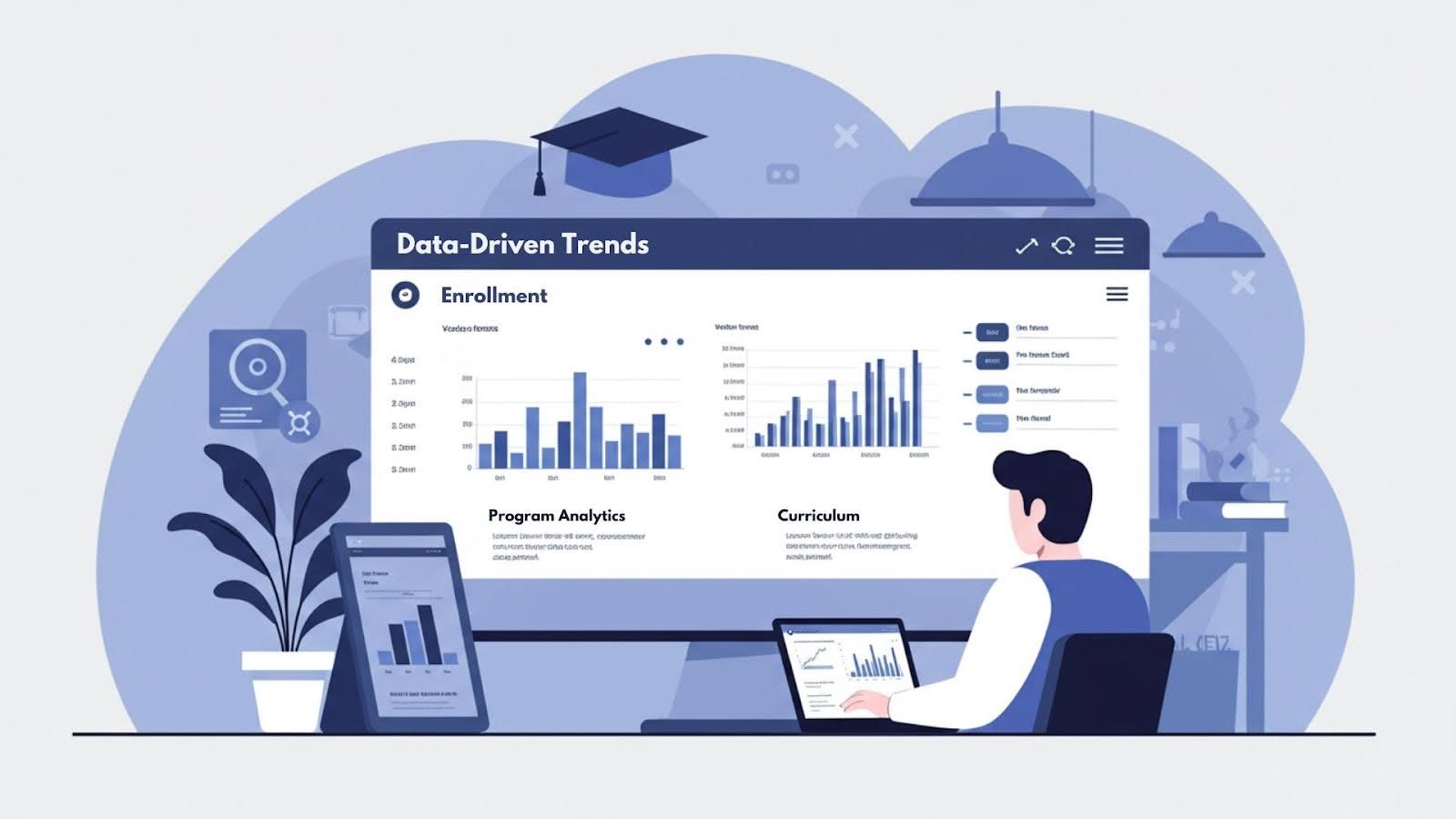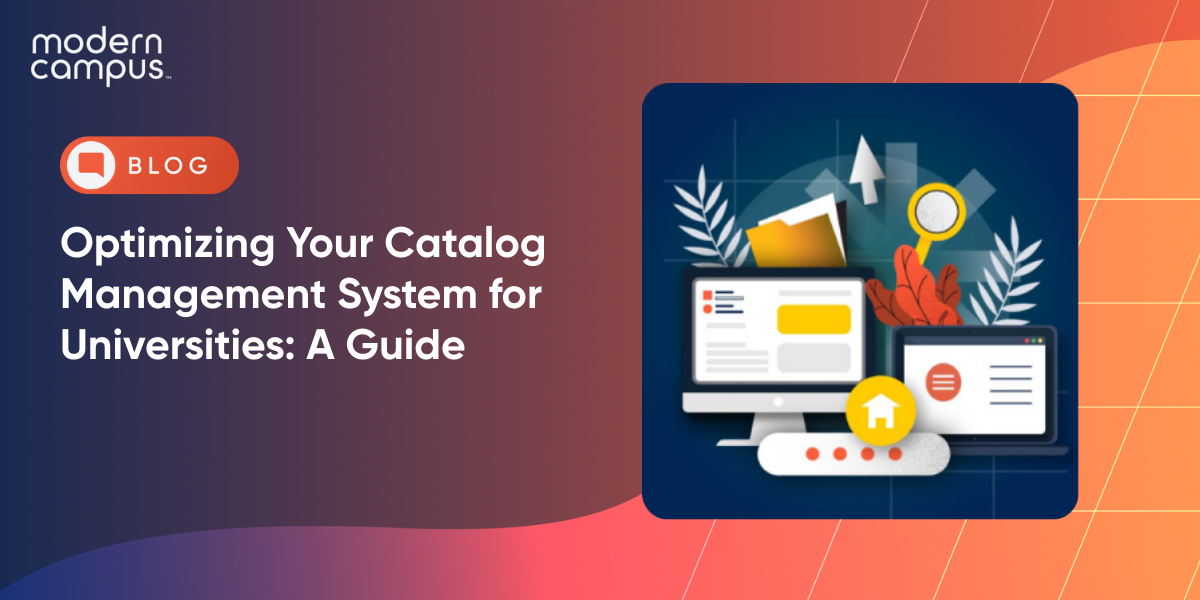Optimizing Your Catalog Management System for Universities: A Guide
A well-structured catalog management system for higher ed institutions is the backbone of an efficient academic institution, ensuring students, faculty and administrators have access to accurate and up-to-date course information. However, many institutions still rely on outdated, manual catalog processes that lead to errors, inconsistencies and unnecessary administrative burden.
Studies show that 81% of students want their campuses to provide digital experiences that extend beyond graduation. As higher education evolves, institutions must embrace digital catalog solutions that streamline curriculum updates, enhance student engagement and support seamless program proposals and approvals.
Optimizing a course catalog goes beyond simple record-keeping—it directly impacts the student experience, enrollment decisions and institutional reputation. A modern approach to catalog management allows universities to adapt quickly to curricular changes, integrate with student information systems and provide a user-friendly digital experience that meets the expectations of today’s learners. With the right strategies and tools, institutions can ensure their catalogs serve as dynamic, accessible resources that drive student success and operational efficiency.
Why Your Institution Needs an Optimized Catalog Management System for Universities
A university’s course catalog shapes the student experience and supports institutional success. Yet, many higher education institutions struggle with outdated catalog systems that create inefficiencies, hinder curricular changes and frustrate students and faculty alike. An optimized system transforms this process, ensuring accuracy, accessibility and streamlined workflows that benefit the entire campus community.
The Role of Course Catalogs in Higher Education
Course catalogs serve as the foundation of academic planning, providing students, faculty and administrators with essential details about programs, courses and degree requirements. When properly managed, they act as a reliable guide for students selecting courses, help faculty align curricula with evolving industry demands and support administrators in maintaining compliance with accreditation standards. A logical, accessible catalog enhances student engagement by offering clear, structured pathways to graduation while improving institutional efficiency.
Common Challenges in University Catalog Management
Managing a catalog manually is a time-consuming process prone to errors and inconsistencies. Many institutions face challenges such as outdated course information, slow approval workflows and difficulty in tracking curricular changes.
These inefficiencies can lead to miscommunication between departments, confusion among students about course availability and delays in launching new programs. Without a centralized, digital solution, faculty and administrators often waste valuable staff time navigating complex curricular approval processes instead of focusing on student success.
The Impact on Student Experience and Institutional Success
An outdated catalog also negatively impacts the student experience. When students encounter missing or incorrect course details, unclear prerequisites or outdated program descriptions, it disrupts their academic planning and may even delay their graduation.
A modern catalog management system for institutions enhances accessibility by integrating with student information systems, offering real-time updates and improving search functionality. By providing students with a seamless and accurate course selection process, institutions can increase enrollment, retention and overall student satisfaction—key drivers of long-term institutional success.
Key Features of a Modern Course Catalog Software
Optimized course catalog software transforms how universities and colleges manage their curricula. Students gain easier access to information, while administration benefits from streamlined workflows. A modern solution ensures accuracy, simplifies the curricular approval process and enhances student engagement by making course selection intuitive and seamless.

Institutions that leverage these advanced tools can free up staff time, improve program visibility and provide a more dynamic experience for both students and faculty.
Seamless Curriculum Management for Faculty and Staff
A digital curriculum management system eliminates the inefficiencies of manual catalog updates. With a centralized platform, faculty and administrators can propose, review and approve curricular changes in real time.
Built-in workflows allow institutions to streamline the process of introducing new programs, modifying course requirements and maintaining compliance with accreditation standards. You can reduce errors and ensure that students always have access to the most up-to-date academic offerings.
Efficient Course Proposal and Approval Processes
Managing course proposals can be an overwhelming task when institutions rely on outdated, paper-based workflows. Modern catalog management software automates the approval process, allowing faculty and department chairs to submit, review and approve course modifications within a structured, efficient system. In turn, institutions can respond faster to industry trends, develop new programs that align with workforce demands and ensure that curricular updates are made without delays.
Enhancing Student Engagement Through Digital Access
Students expect a user-friendly digital experience when navigating their academic options. Intuitive catalog software improves engagement by providing mobile-friendly access, personalized search filters and dynamic catalog pages. Students gain the freedom to explore programs based on their interests and career goals.
By integrating with a student information system, institutions can ensure real-time updates on course availability, prerequisites and scheduling options. An optimized system reduces confusion and makes academic planning easier.
Integration with Student Information Systems (SIS) for Accuracy
A modern scheduling system for universities seamlessly integrates with existing student information systems, ensuring that course details remain consistent across all institutional platforms. With your tools operating in sync, you can eliminate discrepancies between the catalog and the actual course schedule. You'll see fewer registration errors and improved operational efficiency all around.
Maintaining a single source of truth for curricular information, institutions can enhance transparency, simplify advising and empower students to make informed decisions about their academic pathways.
Best Practices for Catalog Creation and Maintenance
Even with the right catalog management system, institutions must implement best practices to ensure accuracy, user-friendliness and alignment with their goals. By prioritizing proactive maintenance, clear communication and data-driven decision-making, universities and colleges can create a catalog that serves as both an academic roadmap for students and an essential tool for faculty and administrators.
Ensuring Accurate and Up-to-Date Program Information
Academic programs evolve constantly, with new courses, prerequisites and graduation requirements introduced each year. Without a structured process in place, outdated information can quickly accumulate, leading to confusion and misinformed course selections.
Institutions should establish a curricular review schedule, ensuring faculty and department chairs routinely audit course descriptions, degree requirements and program details. Additionally, leveraging automated alerts for upcoming curricular changes helps ensure timely updates before registration periods open.
Managing Curricular Changes with a Streamlined Workflow
Changes to degree programs and course offerings often involve multiple stakeholders, from faculty members to accreditation bodies. Without a clear workflow, approval processes can become bottlenecked, delaying updates and frustrating students who rely on accurate course information.
A best practice is to implement role-based workflows, ensuring that program proposals, approvals and modifications follow a structured path with clear deadlines and accountability. Institutions should also consider creating digital archives of past catalogs to provide a historical reference for faculty and accreditation purposes.
Utilizing Actionable Insights for Continuous Improvement
Data-driven decision-making is key to maintaining an effective higher education curriculum management system. Institutions should leverage analytics to monitor course enrollment trends, identify underutilized programs and assess student engagement with the catalog.
For example, if specific courses frequently have low enrollment, it may indicate a need for better course descriptions, adjustments to scheduling or stronger faculty engagement. Additionally, tracking student search behavior within the catalog can reveal gaps in program information, helping institutions refine content and improve user experience.
These best practices can help universities and colleges ensure their program management system remains an invaluable resource that supports academic success, enhances operational efficiency and provides students with the clarity they need to confidently navigate their education.
Improving Student Success with a User-Friendly University Catalog
A catalog should serve as a guiding tool that empowers students to make informed academic decisions. When designed with usability in mind, the catalog becomes a critical part of the student journey, helping them efficiently navigate degree requirements, plan their schedules and stay on track for graduation. An optimized catalog can remove barriers to student success by prioritizing accessibility, clarity and seamless integration with academic planning tools.

Enhancing Navigation and Searchability for Prospective Students
Many students—especially those new to higher education—find traditional course catalogs overwhelming. Pages cluttered with dense text, complex course codes and unclear prerequisites can make academic planning feel like an impossible task.
To improve usability, institutions should implement intelligent search filters that allow students to explore programs by subject, career pathways, skill development or even personal interests. Interactive catalog pages with clear, concise descriptions, visual program maps and links to advising resources help students confidently select courses that align with their goals.
Simplifying Course Numbering and Class Scheduling
A confusing course numbering system can create unnecessary frustration for students trying to understand prerequisites and degree progressions. Institutions can improve clarity by adopting a consistent, intuitive course numbering structure that reflects difficulty level, subject area and sequencing.
Integrating the catalog with class scheduling tools helps students see real-time course availability, allowing them to build balanced schedules that accommodate work, internships or extracurricular activities. Providing personalized recommendations based on students’ degree paths can further streamline the enrollment process.
Leveraging Catalog Pages as a Marketing Tool
Beyond serving current students, the catalog is often one of the first touchpoints for prospective students exploring program offerings. An engaging, digital-first catalog can serve as a powerful recruitment tool, showcasing academic programs, faculty expertise and career outcomes in a compelling way.
Features such as student testimonials, career outlook insights and interactive curriculum pathways can help institutions differentiate their programs and demonstrate their value. Ensuring that catalog pages are mobile-friendly and optimized for search engines also increases visibility, making it easier for prospective students to find the right programs.
A well-designed catalog management system for institutions directly supports student success by providing an intuitive, informative and accessible resource for academic planning. By prioritizing usability, clarity and personalization, institutions can help learners navigate their educational journey.
How an Optimized Curriculum Inventory Management System Supports Growth
An efficient curriculum inventory management system drives institutional growth by reducing administrative burden, improving resource allocation and supporting long-term strategic planning.

Universities and colleges can remain competitive, ensuring that programs align with workforce demands while enhancing student and faculty experiences. Here’s how:
- Reduces Administrative Burden: By automating course updates and approvals, institutions free up staff time that can be reallocated to student support, faculty collaboration and program development.
- Accelerates New Course and Program Development: A modern course management system enables faculty to efficiently propose, review and launch new programs. Institutions can introduce relevant courses aligned with industry trends and workforce needs, attracting more students.
- Improves Institutional Efficiency Across Departments: Integration with SIS ensures consistency in course data across advising, enrollment and scheduling platforms, eliminating redundant manual entry and reducing errors.
- Supports Graduate and Professional Programs: Graduate and continuing education programs often have complex curricular structures with cross-listed courses and flexible learning formats. A centralized system helps institutions manage these intricacies without confusion.
- Enhances Data-Driven Decision Making: Access to actionable insights, such as course enrollment trends, student demand analytics and program performance, allows institutions to refine offerings, eliminate redundant courses and allocate resources effectively.
- Improves Compliance and Accreditation Readiness: Keeping a well-documented, structured curriculum inventory simplifies accreditation reporting and ensures institutions meet evolving academic and regulatory standards.
An optimized curriculum inventory management system is a strategic tool for institutional growth. Universities can enhance student success, attract new enrollments and remain competitive in higher education.
Take Control of Your University Catalog for a More Efficient Future
When done right, an optimized catalog management system for institutions cuts down on bureaucratic headaches, keeps information accurate and accessible and helps students plan their academic journey without confusion. Instead of being a static, outdated document, a modern catalog becomes an interactive, student-friendly resource that evolves with your institution’s needs. By simplifying course approvals, improving searchability and integrating seamlessly with other academic systems, colleges and universities can turn their catalogs into a tool for engagement, efficiency and long-term success.
At Modern Campus, we understand the challenges institutions face when managing course catalogs and curriculum updates. Our solutions are designed exclusively for higher education, helping institutions automate workflows, improve higher education curriculum management and create a seamless student experience. With our advanced software, universities save valuable staff time, ensure up-to-date program information and provide students with the clarity they need to plan their academic journey. Connect with us to explore how we can help transform your catalog management.
Last updated: May 7, 2025

